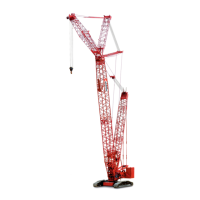SET-UP OPERATOR MANUAL 600E2
4-8 PUBLISHED 04-26-2019 CONTROL # 113-09
NOTE: Crane must be reeved for 2 part to lift the 9,000 lbs
(4082 kg) load.
Two part hoist capacity is 15,400 lbs (6985 kg)
After reeving for 2 part line the new Step 1 calculation is the
weight of load and load handling equipment.
Example 3
A load of 1500 lbs (680 kg) is to be lifted from the roof of a
building at a radius of 30 ft (9.14 m) and a height of 90 ft
(27.43 m) and placed on the ground on the other side of the
truck at a radius of 40 ft (12.19 m).
1. Weight of load and load handling equipment.
2. Starting Radius Given = 30 ft (9.14 m)
3. Ending Radius Given = 40 ft (12.19 m)
4. Refer to Crane load chart.
To reach the load on the roof, the extension must be utilized
to clear the roof with the load.
Both the retracted 25' extension length and extended 45'
extension length have the necessary capacity at a 30' (9.14
m) radius. Only the retracted 23' extension has the capacity
at the 40' (12.19 m) radius to accomplish the task.
Starting Point: With the 23 ft (7 m) extension deployed and
the boom fully extended, the capacity is 2,500 lbs (1134 kg)
at a 30 ft (9.14 m) radius and boom angle of 72.1°.
Ending Point: With the main boom still fully extended, the
capacity is 1,900 lbs (862 kg) at a radius of 40 ft (12.19 m)
and boom angle of 75.5°.
NOTE: The capacity of the extension remains the same
even with the main boom retracted. Operate with
extension by radius when main boom is fully
extended and operate with extension by boom
angle when main boom is not fully extended. Do
not exceed rated extension capacities at any
reduced boom lengths.
5. Refer to hoist load chart.
The capacity of a 1 part lines 7700 lbs (3492 kg) which is well
above the 1,680 lbs (762 kg) to be lifted.
NOTE: The HCA Load Range Gauge does not provide
accurate indication of overload conditions when
operating with a extension deployed. The HCA will
not prevent the crane from being operated in an
overload condition. The extension is equipped with
a extension load limiting device which will prevent
the extension from being operated in an overload
condition.
The operator should proceed to lift the load as smoothly as
possible.
BOOM EXTENSION OPERATION SAFETY
1. The anti-two-block switch weight and cord must be
attached to the extension when deployed.
2. Do not lift load with the boom tip when the extension is
pinned on the boom tip.
3. Operate with extension by radius when main boom is
fully extended. If necessary, increase boom angle to
maintain loaded radius.
When radius is between points listed on load chart, the
load shown at the next longer radius shall be used.
4. Operate with extension by boom angle when main boom
is not fully extended. Do not exceed rated extension
capacities at any reduced boom lengths.
When angle is between points listed on load chart, the
load shown at next lower boom angle shall be used.
5. Ensure extension is stowed correctly.
a. Removal of swing around pins, C, without proper
installation of stow pin A and extension swing pin B,
may allow extension to fall off.
b. Extending boom with extension stowed and failure
to remove swing pins, C, will damage unit upon
extension.
6. Only attempt to swing extension to working or stowed
position when boom is horizontal, stow pin A and
extension swing pin B, are removed and swing pins, C,
are in place. extension could swing uncontrollably if
boom is not horizontal.
7. Crane shall be fully set up according to proper set-up
procedures outlined previously when stowing or
unstowing extension.
Load = 9000 lb (4082 kg)
1 Part Load Block = 200 lb (90.7 kg)
Sling = 50 lb (22 kg)
Total Load = 9250 lb (4195 kg)
Load = 1500 lb (680 kg)
1 Part Load Block = 150 lb (68 kg)
Sling = 30 lb (14 kg)
Total Load = 1680 lb (762 kg)
CAUTION
Do not attempt to deploy the extension until reading and
understanding extension operation information found later
in this section of the manual.
Fo
r
Reference
Only

